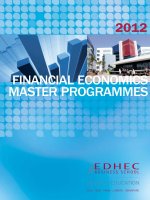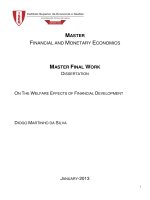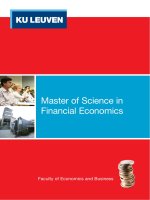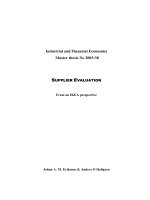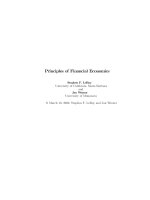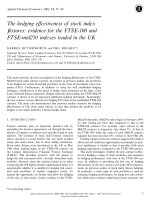Quantitative financial economics
Bạn đang xem bản rút gọn của tài liệu. Xem và tải ngay bản đầy đủ của tài liệu tại đây (3.59 MB, 738 trang )
QUANTITATIVE
FINANCIAL
ECONOMICS
STOCKS, BONDS AND
FOREIGN EXCHANGE
Second Edition
KEITH CUTHBERTSON
AND
DIRK NITZSCHE
QUANTITATIVE
FINANCIAL
ECONOMICS
QUANTITATIVE
FINANCIAL
ECONOMICS
STOCKS, BONDS AND
FOREIGN EXCHANGE
Second Edition
KEITH CUTHBERTSON
AND
DIRK NITZSCHE
Copyright 2004
John Wiley & Sons Ltd, The Atrium, Southern Gate, Chichester,
West Sussex PO19 8SQ, England
Telephone (+44) 1243 779777
Email (for orders and customer service enquiries):
Visit our Home Page on www.wileyeurope.com or www.wiley.com
All Rights Reserved. No part of this publication may be reproduced, stored in a retrieval system or transmitted in any
form or by any means, electronic, mechanical, photocopying, recording, scanning or otherwise, except under the terms of
the Copyright, Designs and Patents Act 1988 or under the terms of a licence issued by the Copyright Licensing Agency
Ltd, 90 Tottenham Court Road, London W1T 4LP, UK, without the permission in writing of the Publisher. Requests to
the Publisher should be addressed to the Permissions Department, John Wiley & Sons Ltd, The Atrium, Southern Gate,
Chichester, West Sussex PO19 8SQ, England, or emailed to , or faxed to (+44) 1243 770620.
Designations used by companies to distinguish their products are often claimed as trademarks. All brand names and
product names used in this book are trade names, service marks, trademarks or registered trademarks of their respective
owners. The Publisher is not associated with any product or vendor mentioned in this book.
This publication is designed to provide accurate and authoritative information in regard to the subject matter covered. It
is sold on the understanding that the Publisher is not engaged in rendering professional services. If professional advice or
other expert assistance is required, the services of a competent professional should be sought.
Other Wiley Editorial Offices
John Wiley & Sons Inc., 111 River Street, Hoboken, NJ 07030, USA
Jossey-Bass, 989 Market Street, San Francisco, CA 94103-1741, USA
Wiley-VCH Verlag GmbH, Boschstr. 12, D-69469 Weinheim, Germany
John Wiley & Sons Australia Ltd, 33 Park Road, Milton, Queensland 4064, Australia
John Wiley & Sons (Asia) Pte Ltd, 2 Clementi Loop #02-01, Jin Xing Distripark, Singapore 129809
John Wiley & Sons Canada Ltd, 22 Worcester Road, Etobicoke, Ontario, Canada M9W 1L1
Wiley also publishes its books in a variety of electronic formats. Some content that appears
in print may not be available in electronic books.
Library of Congress Cataloging-in-Publication Data
Cuthbertson, Keith.
Quantitative financial economics : stocks, bonds and foreign exchange /
Keith Cuthbertson and Dirk Nitzsche. – 2nd ed.
p. cm.
Includes bibliographical references and index.
ISBN 0-470-09171-1 (pbk. : alk. paper)
1. Investments – Mathematical models. 2. Capital assets pricing model. 3.
Stocks – Mathematical models. 4. Bonds – Mathematical models. 5. Foreign
exchange – Mathematical models. I. Nitzsche, Dirk. II. Title.
HG4515.2.C87 2005
332.6 – dc22
2004018706
British Library Cataloguing in Publication Data
A catalogue record for this book is available from the British Library
ISBN 0-470-09171-1
Typeset in 10/13pt Times by Laserwords Private Limited, Chennai, India
Printed and bound in Great Britain by Antony Rowe Ltd, Chippenham, Wiltshire
This book is printed on acid-free paper responsibly manufactured from sustainable forestry
in which at least two trees are planted for each one used for paper production.
To all our students who have done well enough to be in a position to hire finance
consultants
CONTENTS
Preface
Acknowledgements
1 Basic Concepts in Finance
Aims
1.1 Returns on Stocks, Bonds and
Real Assets
1.2 Discounted Present Value, DPV
1.3 Utility and Indifference Curves
1.4 Asset Demands
1.5 Indifference Curves and
Intertemporal Utility
1.6 Investment Decisions and
Optimal Consumption
1.7 Summary
Appendix: Mean-Variance
Model and Utility Functions
xiii
xv
1
1
1
7
13
19
25
28
32
33
2 Basic Statistics in Finance
35
Aims
2.1 Lognormality and Jensen’s
Inequality
35
35
2.2 Unit Roots, Random Walk and
Cointegration
2.3 Monte Carlo Simulation (MCS)
and Bootstrapping
2.4 Bayesian Learning
2.5 Summary
3 Efficient Markets
Hypothesis
Aims
3.1 Overview
3.2 Implications of the EMH
3.3 Expectations, Martingales and
Fair Game
3.4 Testing the EMH
3.5 Using Survey Data
3.6 Summary
Appendix: Cross-Equation
Restrictions
4 Are Stock Returns
Predictable?
Aims
4.1 A Century of Returns
36
40
47
50
53
53
54
56
59
65
66
70
71
73
73
73
viii
CONTENTS
4.2
4.3
4.4
4.5
4.6
4.7
4.8
4.9
Simple Models
Univariate Tests
Multivariate Tests
Cointegration and Error
Correction Models (ECM)
Non-Linear Models
Markov Switching Models
Profitable Trading Strategies?
Summary
82
85
95
100
103
106
109
113
5 Mean-Variance Portfolio
Theory and the CAPM
115
5.1
5.2
5.3
5.4
5.5
Aims
An Overview
Mean-Variance Model
Capital Asset Pricing Model
Beta and Systematic Risk
Summary
6 International Portfolio
Diversification
6.1
6.2
6.3
6.4
Aims
Mathematics of the
Mean-Variance Model
International Diversification
Mean-Variance Optimisation in
Practice
Summary
Appendix I: Efficient Frontier
and the CML
Appendix II: Market Portfolio
7 Performance Measures,
CAPM and APT
7.1
7.2
7.3
7.4
7.5
Aims
Performance Measures
Extensions of the CAPM
Single Index Model
Arbitrage Pricing Theory
Summary
115
115
119
132
134
138
141
141
142
152
156
163
164
167
169
169
169
176
179
181
187
8 Empirical Evidence: CAPM
and APT
189
Aims
8.1 CAPM: Time-Series Tests
8.2 CAPM: Cross-Section Tests
8.3 CAPM, Multifactor Models and
APT
8.4 Summary
Appendix: Fama–MacBeth
Two-Step Procedure
189
189
190
195
202
203
9 Applications of Linear
Factor Models
205
Aims
Event Studies
Mutual Fund Performance
Mutual Fund ‘Stars’?
Summary
205
206
209
227
243
10 Valuation Models and
Asset Returns
245
9.1
9.2
9.3
9.4
Aims
10.1 The Rational Valuation Formula
(RVF)
10.2 Special Cases of the RVF
10.3 Time-Varying Expected Returns
10.4 Summary
11 Stock Price Volatility
Aims
11.1 Shiller Volatility Tests
11.2 Volatility Tests and Stationarity
11.3 Peso Problems and Variance
Bounds Tests
11.4 Volatility and Regression Tests
11.5 Summary
Appendix: LeRoy–Porter and
West Tests
12 Stock Prices: The VAR
Approach
Aims
245
245
248
249
254
255
255
257
261
267
268
269
270
273
273
ix
CONTENTS
12.1 Linearisation of Returns and the
RVF
12.2 Empirical Results
12.3 Persistence and Volatility
12.4 Summary
Appendix: Returns, Variance
Decomposition and Persistence
13 SDF Model and the
C-CAPM
Aims
13.1 Consumption-CAPM
13.2 C-CAPM and the ‘Standard’
CAPM
13.3 Prices and Covariance
13.4 Rational Valuation Formula and
SDF
13.5 Factor Models
13.6 Summary
Appendix: Joint Lognormality
and Power Utility
14 C-CAPM: Evidence and
Extensions
Aims
14.1 Should Returns be Predictable
in the C-CAPM?
14.2 Equity Premium Puzzle
14.3 Testing the Euler Equations of
the C-CAPM
14.4 Extensions of the SDF Model
14.5 Habit Formation
14.6 Equity Premium: Further
Explanations
14.7 Summary
Appendix: Hansen–Jagannathan
Bound
15 Intertemporal Asset
Allocation: Theory
Aims
15.1 Two-Period Model
15.2 Multi-Period Model
274
280
291
295
296
303
303
304
309
314
315
315
317
318
323
323
323
327
332
336
346
350
353
15.3 SDF Model of Expected Returns
15.4 Summary
Appendix I: Envelope Condition
for Consumption-Portfolio
Problem
Appendix II: Solution for Log
Utility
16 Intertemporal Asset
Allocation: Empirics
Aims
16.1 Retirement and Stochastic
Income
16.2 Many Risky Assets
16.3 Different Preferences
16.4 Horizon Effects and Uncertainty
16.5 Market Timing and Uncertainty
16.6 Stochastic Parameters
16.7 Robustness
16.8 Summary
Appendix: Parameter
Uncertainty and Bayes
Theorem
355
356
362
369
370
375
375
375
381
383
386
389
390
391
392
393
17 Rational Bubbles and
Learning
397
Aims
Rational Bubbles
Tests of Rational Bubbles
Intrinsic Bubbles
Learning
Summary
397
397
401
404
409
420
17.1
17.2
17.3
17.4
17.5
18 Behavioural Finance and
Anomalies
423
354
355
368
368
18.1
18.2
18.3
18.4
18.5
18.6
Aims
Key Ideas
Beliefs and Preferences
Survival of Noise Traders
Anomalies
Corporate Finance
Summary
423
423
428
430
433
447
449
x
CONTENTS
19 Behavioural Models
Aims
19.1 Simple Model
19.2 Optimising Model of Noise
Trader Behaviour
19.3 Shleifer–Vishny Model:
Short-Termism
19.4 Contagion
19.5 Beliefs and Expectations
19.6 Momentum and Newswatchers
19.7 Style Investing
19.8 Prospect Theory
19.9 Summary
Appendix I: The DeLong et al
Model of Noise Traders
Appendix II: The
Shleifer–Vishny Model of
Short-Termism
20 Theories of the Term
Structure
20.1
20.2
20.3
20.4
Aims
Prices, Yields and the RVF
Theories of the Term Structure
Expectations Hypothesis
Summary
451
451
452
454
460
463
466
468
470
475
484
23.1
23.2
23.3
23.4
486
489
489
490
494
498
500
501
502
506
511
513
22 Empirical Evidence on the
Term Structure
515
Aims
22.1 Data and Cointegration
22.2 Variance Bounds Tests
23 SDF and Affine Term
Structure Models
485
21 The EH – From Theory to
Testing
501
Aims
21.1 Alternative Representations of
the EH
21.2 VAR Approach
21.3 Time-Varying Term
Premium – VAR Methodology
21.4 Summary
22.3 Single-Equation Tests
22.4 Expectations Hypothesis: Case
Study
22.5 Previous Studies
22.6 Summary
515
516
518
Aims
SDF Model
Single-Factor Affine Models
Multi-Factor Affine Models
Summary
Appendix I: Math of SDF
Model of Term Structure
Appendix II: Single-Factor
Affine Models
24 The Foreign Exchange
Market
Aims
Exchange Rate Regimes
PPP and LOOP
Covered-Interest Parity, CIP
Uncovered Interest Parity, UIP
Forward Rate Unbiasedness,
FRU
24.6 Real Interest Rate Parity
24.7 Summary
Appendix: PPP and the
Wage–Price Spiral
24.1
24.2
24.3
24.4
24.5
520
523
532
536
537
537
537
541
543
544
545
546
549
549
549
552
560
561
562
562
563
564
25 Testing CIP, UIP and FRU 567
25.1
25.2
25.3
25.4
25.5
25.6
Aims
Covered Interest Arbitrage
Uncovered Interest Parity
Forward Rate Unbiasedness,
FRU
Testing FRU: VAR
Methodology
Peso Problems and Learning
Summary
567
567
572
574
581
586
589
xi
CONTENTS
26 Modelling the FX Risk
Premium
Aims
26.1 Implications of β < 1 in FRU
Regressions
26.2 Consumption-CAPM
26.3 Affine Models of FX Returns
26.4 FRU and Cash-in-Advance
Models
26.5 Summary
27 Exchange Rate and
Fundamentals
Aims
27.1 Monetary Models
27.2 Testing the Models
27.3 New Open-Economy
Macroeconomics
27.4 Summary
28 Market Risk
Aims
28.1 Measuring VaR
591
591
28.2
28.3
28.4
28.5
28.6
592
593
597
598
605
607
607
607
617
624
625
627
627
628
Mapping Assets: Simplifications
Non-Parametric Measures
Monte Carlo Simulation
Alternative Methods
Summary
Appendix I: Monte Carlo
Analysis and VaR
Appendix II: Single Index
Model (SIM)
29 Volatility and Market
Microstructure
635
638
641
645
647
648
650
653
Aims
Volatility
What Influences Volatility?
Multivariate GARCH
Market Microstructure–FX
Trading
29.5 Survey Data and Expectations
29.6 Technical Trading Rules
29.7 Summary
672
674
679
681
References
683
29.1
29.2
29.3
29.4
Recommended Reading
Index
653
654
656
665
711
713
P R E FA C E
Numerous emails and the fact that the first edition sold out suggests that many found
it a positive NPV investment. This is encouraging, as unless these things are turned
into a major motion picture, the cash rewards to the author are not great. My wife
currently believes that the direct return per hour of effort is less than that of a competent plumber – and she’s right. But she has yet to factor in positive externalities and
real options theory – that’s my counter argument anyway. Nevertheless, being risk
averse and with time-varying long-term net liabilities, I do not intend giving up my
day job(s).
When invited to dinner, accompanied by the finest wines someone else can buy,
and asked to produce a second edition, there comes a critical point late in the evening
when you invariably say, ‘Yes’. This is a mistake. The reason is obvious. Were it not
for electronic copies, the mass of ‘stuff’ in this area that has appeared over the last
10 years would fill the Albert Hall. The research and first draft were great, subsequent
drafts less so and by the end it was agony – Groundhog Day. For me this could have
easily been ‘A Book Too Far’. But fortuitously, for the second edition, I was able to
engage an excellent forensic co-author in Dirk Nitzsche.
For those of you who bought the first edition, a glance at the ‘blurb’ on the cover
tells you that the second edition is about 65% new material and the ‘old material’
has also been revamped. We hope we have chosen a coherent, interesting and varied
range of topics. For those who illegally photocopied the first edition and maybe also
got me to sign it – the photocopy that is – I admire your dedication to the cause of
involuntary personal contributions to foreign aid. But I hope you think that for this
much-improved second edition, you could ‘Show Me The Money’.
xiv
P R E FA C E
Who’s it for?
The book is aimed at students on quantitative MSc’s in finance and financial economics
and should also be useful on PhD programmes. All you need as a pre-requisite is a
basic undergraduate course in theory of finance (with the accompanying math) and
something on modern time-series econometrics. Any finance practitioners who want
to ‘get a handle’ on whether there is any practical value in all that academic stuff
(answer, ‘Yes there is – sometimes’), should also dip in at appropriate points. At least,
you will then be able to spot whether the poor Emperor, as he emerges from his ivory
tower and saunters into the market place, is looking sartorially challenged.
In the book, we cover the main theoretical ideas in the pricing of (spot) assets and
the determination of strategic investment decisions (using discrete time analysis), as
well as analysing specific trading strategies. Illustrative empirical results are provided,
although these are by no means exhaustive (or we hope exhausting). The emphasis is on
the intuition behind the finance and economic concepts and the math and stats we need
to analyse these ideas in a rigorous fashion. We feel that the material allows ‘entry’
into recent research work in these areas and we hope it also encourages the reader to
move on to explore derivatives pricing, financial engineering and risk management.
We hope you enjoy the book and it leads you to untold riches – who knows, maybe
this could be the beginning of a beautiful friendship. Anyway, make the most of it, as
after all our past efforts, our goal from now on is to understand everything and publish
nothing. Whether this will increase social welfare, only time and you can tell.
Keith Cuthbertson
Dirk Nitzsche
October 2004
ACKNOWLEDGEMENTS
Special thanks go to our colleagues at CASS Business School, London, for practical
insights into many of the topics in the book and also to our colleagues at Tanaka
Business School, Imperial College, London. The MSc and PhD students at the above
institutions and at the University of Bordeaux-IV, UNAM in Mexico City and the Freie
University, Berlin, have also been excellent, critical and attentive ‘guinea pigs’.
In particular, we should like to thank the following people for reading draft chapters:
Mike Artis, Don Bredin, Francis Breedon, Ian Buckley, Alec Chrystal, David Barr, Lara
Cathcart, Ales Cerny, Lina El-Jahel, Luis Galindo, Stephen Hall, Richard Harris, Simon
Hayes, Stuart Hyde, Turalay Kenc, David Miles, Michael Moore, Kerry Patterson, Mark
Salmon, Lucio Sarno, Peter Smith, Mark Taylor, Dylan Thomas and Mike Wickens.
Also, Tom Engsted at the University of Aarhus and Richard Harris at the University
of Exeter kindly provided some corrections to the first edition, which we hope have
been accurately incorporated into the second edition. In addition, Niall O’Sullivan
has given permission to use part of his PhD material on mutual fund performance in
Chapter 9 and Ales Cerny allowed us early access to the drafts of his book Mathematical Techniques in Finance (Princeton University Press 2004).
Many thanks to Yvonne Doyle at Imperial College, who expertly typed numerous
drafts and is now well on her way to becoming an expert in Greek.
1
BASIC CONCEPTS IN
FINANCE
Aims
• To consider different methods of measuring returns for pure discount bonds, couponpaying bonds and stocks.
• Use discounted present value techniques, DPV, to price assets.
• Show how utility functions can be used to incorporate risk aversion, and derive asset
demand functions from one-period utility maximisation.
• Illustrate the optimal level of physical investment and consumption for a two-period
horizon problem.
The aim of this chapter is to quickly run through some of the basic tools of analysis
used in finance literature. The topics covered are not exhaustive and they are discussed
at a fairly intuitive level.
1.1 Returns on Stocks, Bonds and Real Assets
Much of the theoretical work in finance is conducted in terms of compound rates of
return or interest rates, even though rates quoted in the market use ‘simple interest’. For
example, an interest rate of 5 percent payable every six months will be quoted as a simple interest rate of 10 percent per annum in the market. However, if an investor rolled
over two six-month bills and the interest rate remained constant, he could actually earn
a ‘compound’ or ‘true’ or ‘effective’ annual rate of (1.05)2 = 1.1025 or 10.25 percent.
The effective annual rate of return exceeds the simple rate because in the former case
the investor earns ‘interest-on-interest’.
2
CHAPTER 1
/
BASIC CONCEPTS IN FINANCE
We now examine how we calculate the terminal value of an investment when the
frequency with which interest rates are compounded alters. Clearly, a quoted interest
rate of 10 percent per annum when interest is calculated monthly will amount to more
at the end of the year than if interest accrues only at the end of the year.
Consider an amount $A invested for n years at a rate of R per annum (where R is
expressed as a decimal). If compounding takes place only at the end of the year, the
future value after n years is FV n , where
FV n = $A(1 + R)n
(1)
However, if interest is paid m times per annum, then the terminal value at the end of
n years is
mn
(2)
FV m
n = $A(1 + R/m)
R/m is often referred to as the periodic interest rate. As m, the frequency of compounding, increases, the rate becomes ‘continuously compounded’, and it may be shown that
the investment accrues to
(3)
FV cn = $AeRc n
where Rc = the continuously compounded rate per annum. For example, if the quoted
(simple) interest rate is 10 percent per annum, then the value of $100 at the end of
one year (n = 1) for different values of m is given in Table 1. For daily compounding,
with R = 10% p.a., the terminal value after one year using (2) is $110.5155. Assuming
Rc = 10% gives FV cn = $100e0.10(1) = $100.5171. So, daily compounding is almost
equivalent to using a continuously compounded rate (see the last two entries in Table 1).
We now consider how to switch between simple interest rates, periodic rates, effective annual rates and continuously compounded rates. Suppose an investment pays a
periodic interest rate of 2 percent each quarter. This will usually be quoted in the market as 8 percent per annum, that is, as a simple annual rate. At the end of the year,
$A = $100 accrues to
$A(1 + R/m)m = 100(1 + 0.08/4)4 = $108.24
(4)
The effective annual rate Re is 8.24% since $100(1 + Re ) = 108.24. Re exceeds the
simple rate because of the payment of interest-on-interest. The relationship between
Table 1
Compounding frequency
Compounding Frequency
Annually (m = 1)
Quarterly (m = 4)
Weekly (m = 52)
Daily (m = 365)
Continuous (n = 1)
Value of $100 at End of Year
(R = 10% p.a.)
110.00
110.38
110.51
110.5155
110.5171
SECTION 1.1
/
RETURNS ON STOCKS, BONDS AND REAL ASSETS
3
the quoted simple rate R with payments m times per year and the effective annual rate
Re is
(1 + Re ) = (1 + R/m)m
(5)
We can use (5) to move from periodic interest rates to effective rates and vice versa.
For example, an interest rate with quarterly payments that would produce an effective
annual rate of 12 percent is given by 1.12 = (1 + R/4)4 , and hence,
R = [(1.12)1/4 − 1]4 = 0.0287(4) = 11.48%
(6)
So, with interest compounded quarterly, a simple interest rate of 11.48 percent per
annum is equivalent to a 12 percent effective rate.
We can use a similar procedure to switch between a simple interest rate R, which
applies to compounding that takes place over m periods, and an equivalent continuously
compounded rate Rc . One reason for doing this calculation is that much of the advanced
theory of bond pricing (and the pricing of futures and options) uses continuously
compounded rates.
Suppose we wish to calculate a value for Rc when we know the m-period rate R.
Since the terminal value after n years of an investment of $A must be equal when
using either interest rate we have
Ae Rc n = A(1 + R/m)mn
(7)
Rc = m ln[1 + R/m]
(8)
and therefore,
Also, if we are given the continuously compounded rate Rc , we can use the above
equation to calculate the simple rate R, which applies when interest is calculated m
times per year:
R = m(eRc /m − 1)
(9)
We can perhaps best summarise the above array of alternative interest rates by using
one final illustrative example. Suppose an investment pays a periodic interest rate of
5 percent every six months (m = 2, R/2 = 0.05). In the market, this might be quoted
as a ‘simple rate’ of 10 percent per annum. An investment of $100 would yield 100[1 +
(0.10/2)]2 = $110.25 after one year (using equation 2). Clearly, the effective annual
rate is 10.25% p.a. Suppose we wish to convert the simple annual rate of R = 0.10 to
an equivalent continuously compounded rate. Using (8), with m = 2, we see that this
is given by Rc = 2 ln(1 + 0.10/2) = 0.09758 (9.758% p.a.). Of course, if interest is
continuously compounded at an annual rate of 9.758 percent, then $100 invested today
would accrue to 100 eRc ·n = $110.25 in n = 1 year’s time.
Arithmetic and Geometric Averages
Suppose prices in successive periods are P0 = 1, P1 = 0.7 and P2 = 1, which correspond to (periodic) returns of R1 = −0.30 (−30%) and R2 = 0.42857 (42.857%).
The arithmetic average return is R = (R1 + R2 )/2 = 6.4285%. However, it would be
4
CHAPTER 1
/
BASIC CONCEPTS IN FINANCE
incorrect to assume that if you have an initial wealth W0 = $100, then your final wealth
after 2 periods will be W2 = (1 + R)W0 = $106.4285. Looking at the price series it
is clear that your wealth is unchanged between t = 0 and t = 2:
W2 = W0 [(1 + R1 )(1 + R2 )] = $100 (0.70)(1.42857) = $100
Now define the geometric average return as
(1 + R g )2 = (1 + R1 )(1 + R2 ) = 1
Here R g = 0, and it correctly indicates that the return on your ‘wealth portfolio’
Rw (0 → 2) = (W2 /W0 ) − 1 = 0 between t = 0 and t = 2. Generalising, the geometric
average return is defined as
(1 + R g )n = (1 + R1 )(1 + R2 ) · · · (1 + Rn )
and we can always write
(10)
Wn = W0 (1 + R g )n
Unless (periodic) returns Rt are constant, the geometric average return is always less
than the arithmetic average return. For example, using one-year returns Rt , the geometric average return on a US equity value weighted index over the period 1802–1997
is 7% p.a., considerably lower than the arithmetic average of 8.5% p.a. (Siegel 1998).
If returns are serially uncorrelated, Rt = µ + εt with εt ∼ iid(0, σ 2 ), then the arithmetic average is the best return forecast for any randomly selected future year. Over
long holding periods, the best forecast would also use the arithmetic average return
compounded, that is, (1 + R)n . Unfortunately, the latter clear simple result does not
apply in practice over long horizons, since stock returns are not iid.
In our simple example, if the sequence is repeated, returns are negatively serially
correlated (i.e. −30%, +42.8%, alternating in each period). In this case, forecasting
over long horizons requires the use of the geometric average return compounded,
(1 + R g )n . There is evidence that over long horizons stock returns are ‘mildly’ mean
reverting (i.e. exhibit some negative serial correlation) so that the arithmetic average
overstates expected future returns, and it may be better to use the geometric average
as a forecast of future average returns.
Long Horizons
The (periodic) return is (1 + R1 ) = P1 /P0 . In intertemporal models, we often require
an expression for terminal wealth:
Wn = W0 (1 + R1 )(1 + R2 ) · · · (1 + Rn )
Alternatively, this can be expressed as
ln(Wn /W0 ) = ln(1 + R1 ) + ln(1 + R2 ) + · · · + ln(1 + Rn )
= (Rc1 + Rc2 + · · · + Rcn ) = ln(Pn /P0 )
SECTION 1.1
/
RETURNS ON STOCKS, BONDS AND REAL ASSETS
5
where Rct ≡ ln(1 + Rt ) are the continuously compounded rates. Note that the term in
parentheses is equal to ln(Pn /P0 ). It follows that
Wn = W0 exp(Rc1 + Rc2 + · · · + Rcn ) = W0 (Pn /P0 )
Continuously compounded rates are additive, so we can define the (total continuously
compounded) return over the whole period from t = 0 to t = n as
Rc (0 → n) ≡ (Rc1 + Rc2 + · · · + Rcn )
Wn = W0 exp[Rc (0 → n)]
Let us now ‘connect’ the continuously compounded returns to the geometric average
return. It follows from (10) that
ln(1 + R g )n = (Rc1 + Rc2 + · · · + Rcn ) ≡ Rc (0 → n)
Hence
Wn = W0 exp[ln(1 + R g )n ] = W0 (1 + R g )n
as we found earlier.
Nominal and Real Returns
A number of asset pricing models focus on real rather than nominal returns. The real
return is the (percent) rate of return from an investment, in terms of the purchasing
power over goods and services. A real return of, say, 3% p.a. implies that your initial
investment allows you to purchase 3% more of a fixed basket of domestic goods (e.g.
Harrod’s Hamper for a UK resident) at the end of the year.
g
If at t = 0 you have a nominal wealth W0 , then your real wealth is W0r = W0 /Po ,
g
where P = price index for goods and services. If R = nominal (proportionate) return
on your wealth, then at the end of year-1 you have nominal wealth of W0 (1 + R) and
real wealth of
g
(W0r Po )(1 + R)
W1
W1r ≡ g =
g
P1
P1
Hence, the increase in your real wealth or, equivalently, your (proportionate) real
return is
(1 + R r ) ≡ W1r /W0r = (1 + R)/(1 + π)
Rr ≡
g
W1r
W0r
=
R−π
≈R−π
1+π
(11)
(12)
g
where 1 + π ≡ (P1 /P0 ). The proportionate change in real wealth is your real return
R r , which is approximately equal to the nominal return R minus the rate of goods
price inflation, π. In terms of continuously compounded returns,
g
ln(W1r /W0r ) ≡ Rcr = ln(1 + R) − ln(P1 /Pog ) = Rc − πc
(13)
6
CHAPTER 1
/
BASIC CONCEPTS IN FINANCE
where Rc = (continuously compounded) nominal return and πc = continuously
compounded rate of inflation. Using continuously compounded returns has the advantage that the log real return over a horizon t = 0 to t = n is additive:
Rcr (0 → n) = (Rc1 − πc1 ) + (Rc2 − πc2 ) + · · · + (Rcn − πcn )
r
r
r
+ Rc2
+ · · · + Rcn
)
= (Rc1
(14)
Using the above, if initial real wealth is W0r , then the level of real wealth at t =
r
r
r
n
n is Wnr = W0r eRc (0→n) = W0r e(Rc1 +Rc2 +···+Rcn ) . Alternatively, if we use proportionate
changes, then
Wnr = W0r (1 + R1r )(1 + R2r ) · · · (1 + Rnr )
(15)
and the annual average geometric real return from t = 0 to t = n, denoted R r,g is
given by
(1 + R r,g ) = n (1 + R1r )(1 + R2r ) · · · (1 + Rn )r
and Wnr = W0r (1 + R r,g )n
Foreign Investment
Suppose you are considering investing abroad. The nominal return measured in terms of
your domestic currency can be shown to equal the foreign currency return (sometimes
called the local currency return) plus the appreciation in the foreign currency. By
investing abroad, you can gain (or lose) either from holding the foreign asset or from
changes in the exchange rate. For example, consider a UK resident with initial nominal
wealth W0 who exchanges (the UK pound) sterling for USDs at a rate S0 (£s per $)
and invests in the United States with a nominal (proportionate) return R us . Nominal
wealth in Sterling at t = 1 is
W1 =
Hence, using S1 = S0 +
for a UK investor is
W0 (1 + R us )S1
S0
(16)
S1 , the (proportionate) nominal return to foreign investment
R(UK → US ) ≡ (W1 /W0 ) − 1 = R us +
S1 /S0 + R us ( S1 /S0 ) ≈ R US + R FX
(17)
where R FX = S1 /S0 is the (proportionate) appreciation of FX rate of the USD against
sterling, and we have assumed that R us ( S1 /S0 ) is negligible. The nominal return to
foreign investment is obviously
Nominal return(UK resident) = local currency(US)return + appreciation of USD
In terms of continuously compound returns, the equation is exact:
Rc (UK → US ) ≡ ln(W1 /W0 ) = Rcus +
s
(18)
SECTION 1.2
/
D I S C O U N T E D P R E S E N T VA L U E , D P V
7
where Rcus ≡ ln(1 + R us ) and s ≡ ln(S1 /S0 ). Now suppose you are concerned about
the real return of your foreign investment, in terms of purchasing power over domestic
goods. The real return to foreign investment is just the nominal return less the domestic
rate of price inflation. To demonstrate this, take a UK resident investing in the United
States, but ultimately using any profits to spend on UK goods. Real wealth at t = 1,
in terms of purchasing power over UK goods is
g
W1r
(W0r Po )(1 + R us )S1
=
g
P1 S0
(19)
It follows that the continuously compounded and proportionate real return to foreign
investment is
Rcr (UK → US ) ≡ ln(W1r /W0r ) = Rcus +
R (UK → US ) ≡
r
W1r /W0r
≈R +R
us
s − πcuk
FX
−π
uk
(20)
(21)
where s = ln(S1 /S0 ). Hence, the real return R r (UK → US ) to a UK resident in
terms of UK purchasing power from a round-trip investment in US assets is
Real return (UK resident) = nominal ‘local currency’ return in US
+ appreciation of USD − inflation in UK
From (20) it is interesting to note that the real return to foreign investment for a UK
resident Rcr (UK → US ) would equal the real return to a US resident investing in the
US, (Rcus − πcus ) if
(22)
πcuk − πcus = s
As we shall see in Chapter 24, equation (22) is the relative purchasing power parity
(PPP) condition. Hence, if relative PPP holds, the real return to foreign investment
is equal to the real local currency return Rcus − πcus , and the change in the exchange
rate is immaterial. This is because, under relative PPP, the exchange rate alters to just
offset the differential inflation rate between the two countries. As relative PPP holds
only over horizons of 5–10 years, the real return to foreign investment over shorter
horizons will depend on exchange rate changes.
1.2 Discounted Present Value, DPV
Let the quoted annual rate of interest on a completely safe investment over n years
be denoted as rn . The future value of $A in n years’ time with interest calculated
annually is
(23)
FV n = $A(1 + rn )n
It follows that if you were given the opportunity to receive with certainty $FVn in
n years’ time, then you would be willing to give up $A today. The value today of
